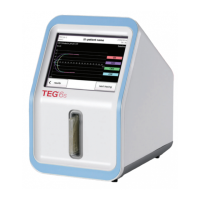What to do if I get 'Initial Frequency Error' on Haemonetics Laboratory Equipment?
- DDana AllenAug 30, 2025
If the starting frequency is outside of allowed limits, remove the cartridge and rerun the test using a new cartridge.

What to do if I get 'Initial Frequency Error' on Haemonetics Laboratory Equipment?
If the starting frequency is outside of allowed limits, remove the cartridge and rerun the test using a new cartridge.
What to do if the Haemonetics Laboratory Equipment shows 'Sample delivery timeout'?
If the delivery of the sample to the test area did not complete in the expected time, remove the cartridge and rerun the test using a new cartridge. Verify that the volume of the blood sample is sufficient for the test. Fill up to or above the line marked on the side of the cartridge.
What to do if there is a data processing error in one or more channels of Haemonetics Laboratory Equipment, indicated by sudden optical sensor output change?
If there is an unexpected change from the optical sensor, remove the cartridge and rerun the test using a new cartridge.
What to do if sample initial fill level is out of range for one or more channels in Haemonetics Laboratory Equipment?
If too little sample was delivered to the cartridge rings, remove the cartridge and rerun the test using a new cartridge. This may indicate issues with optics, pressure or cartridge.
What to do if sample has evaporated in one or more channels of Haemonetics Laboratory Equipment?
If sample evaporation occurred during a test, remove the cartridge and rerun the test using a new cartridge.
What to do if bubbles are detected in the channel of Haemonetics Laboratory Equipment?
If bubbles have been detected in one or more channels, remove the cartridge and rerun the test using a new cartridge. Also, verify that the quantity of the blood sample is sufficient for the test.
What does it mean when Haemonetics Laboratory Equipment says 'Over 90% of stored patient records have not been backed-up or printed'?
| Power Supply | 100-240 V AC, 50/60 Hz |
|---|---|
| Sample Type | Whole blood |
| Display | Touchscreen LCD |
| Connectivity | USB, Ethernet |
| Parameters Measured | R, K, Angle, MA, LY30 |
| Sample Volume | 360 μL |
| Operating Temperature | 15-30°C |
| Technology | Thromboelastography |
| Channels | 1 |
| Operating Humidity | 20% to 80% non-condensing |
| Test Cartridge Type | TEG Cartridge |
Introduction to the manual and system components, including the TEG 6s analyzer.
Important safety and operational warnings for users to follow during operation.
Information on training, repair, and contact details for Haemonetics support.
Explanation of document and analyzer icons and their meanings.
General introduction to the TEG 6s analyzer system and its components.
Details of the analyzer's LCD touchscreen and cartridge slot.
Details of the analyzer's carrying handle, cooling fan, and ports.
Description of test cartridges, including sample port and barcode.
Guidelines for unpacking, placement, and safe storage of the analyzer.
Key safety warnings for electrical shock and handling bloodborne pathogens.
Precautions for handling glass tubes and vials to prevent injury.
Introduction to chapter topics covering analyzer setup and operation.
Principles and operation of the TEG analyzer.
Initial setup, power connection, and user login procedures.
Navigation of the user interface, including the home screen and icons.
How to read numerical and graphical test data on the results screen.
Understanding superimposed and individual channel tracing views.
Adjusting date, time, timezone, and network settings on the analyzer.
Introduction to the analyzer's operational procedures.
Handling, insertion, and verification of disposable assay cartridges.
Proper collection and handling of blood samples for testing.
Step-by-step guide for performing patient tests on the analyzer.
Procedures for manually stopping an ongoing test.
Accessing and reviewing historical patient test results.
Running QC tests to verify analyzer performance and accuracy.
Accessing and reviewing historical quality control results.
Descriptions of common error, warning, and critical alert messages.
Procedures for cleaning and disinfecting the analyzer surfaces.
Specific instructions for cleaning the analyzer's air filter.
Physical, environmental, and electrical characteristics of the analyzer.
Recommended printer for use with the TEG analyzer.
FCC compliance and product warranty details.